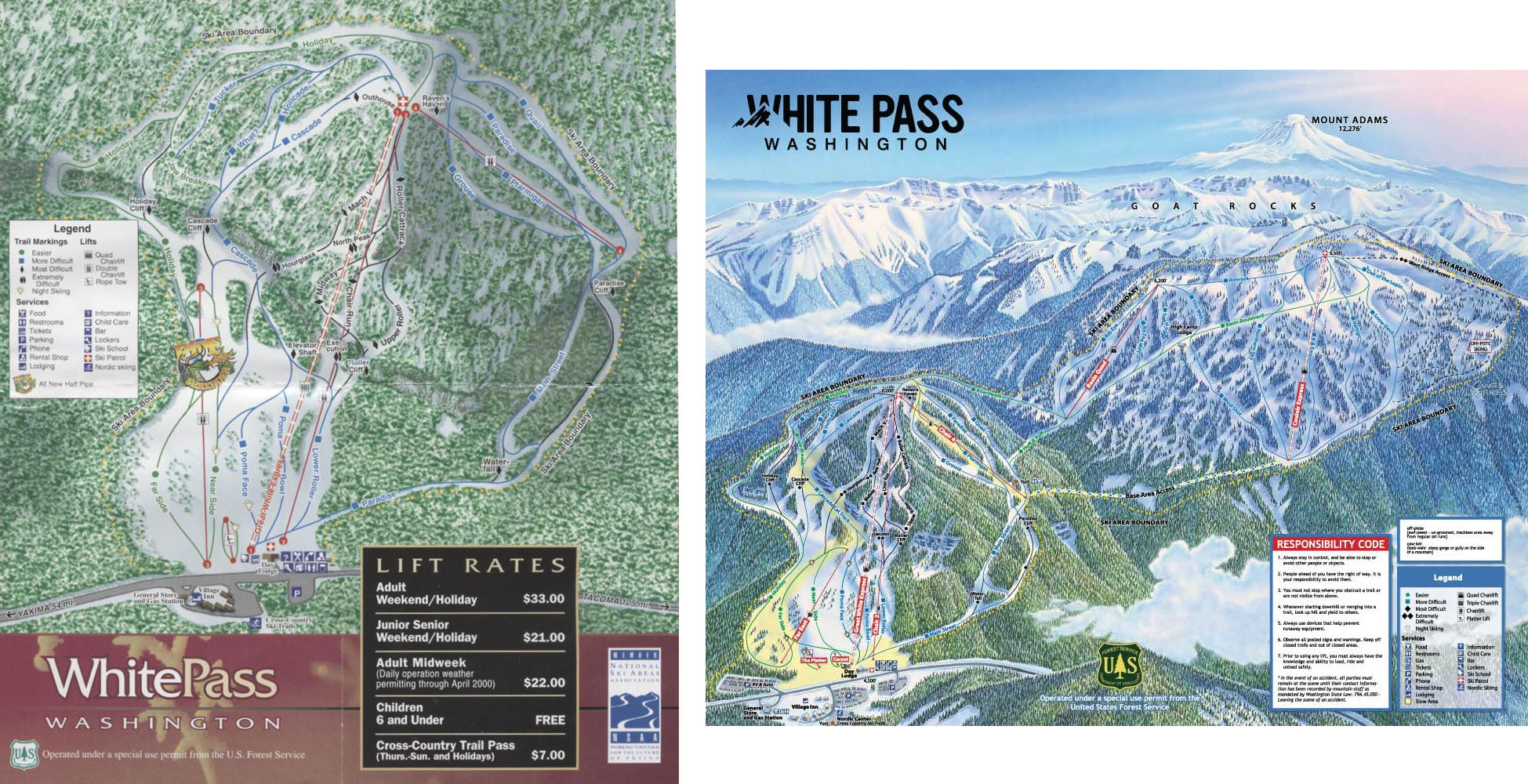Here we are a month or so past the end of the 2021/2022 ski season. On trend with the previous two years, it was another challenging season that demonstrated the problems skiing faces in the PNW. This post is part of a series about the future of skiing and winter recreation in the PNW and how we can potentially go about addressing those problems. Previously I explored what prevented expansion of our ski areas and how the Cascades snowpack is responding to climate change.
This third post explores what our existing ski areas can do to adapt to the overwhelming demand resulting from growing popularity of winter sports and the rapid Western Washington population growth. Specifically, how this can be done through expansion of terrain and chairlift capacity.
Disclaimer
First off, I always start these with a disclaimer: I am not a civil engineer, surveyor, ski area operator, or anyone with a background in or credibility on the topics discussed on this page. I am just a passionate skier who loves the PNW and wants to explore how the problems facing ski culture here could be addressed. I am always open to constructive criticism if you have anything I missed to add or are interested in these topics and want to discuss them further. Please reach out if so (see email in header).
Why do we need expanded skiing & winter recreation capacity?
Anyone that has tried to go to Stevens Pass, Crystal Mountain, or Snoqualmie Pass on a mid-winter weekend in the past few years is well aware of how crowded they are even on an average, non-powder filled weekend. It is great that there is so much interest in skiing and winter sports, but our ski areas have not kept up with population growth in the past few decades.
Washington’s population has increased from 4.9M in 1990 to 7.6M in 2022. Meanwhile, according to the National Ski Areas Association, in 1996 (the earliest year data for the PNW specifically is available) there were 3M visits to ski areas in the PNW compared to 4.5M visits in 2021, a 50% increase.1 This tracks nearly identically with the overall Washington population increase over the same time period.
Knowing how closely skier visits growth matches with the overall population growth, looking forward 30 years Washington’s population is expected to grow by another 30% by 2050.2 Given that our ski areas are already over capacity, are we prepared to deal with another 30% increase of demand on our ski areas by 2050? Seeing as it takes decades for permitting to expand our ski areas, unless we start planning for this increase now we will be woefully unprepared for the future.
But let’s take a look at what has happened in the preceding 30 years first. Despite this population increase since 1990 only modest ski area expansions have taken place during that same time period. Consider the 1990 (left) vs. 2022-ish (right) trail maps for our local ski areas below and note how similar they look today in terms of terrain as they did 30 years ago.
Mt. Baker (why does Baker’s trail map look like a cloudy day now? the colors were nice!):
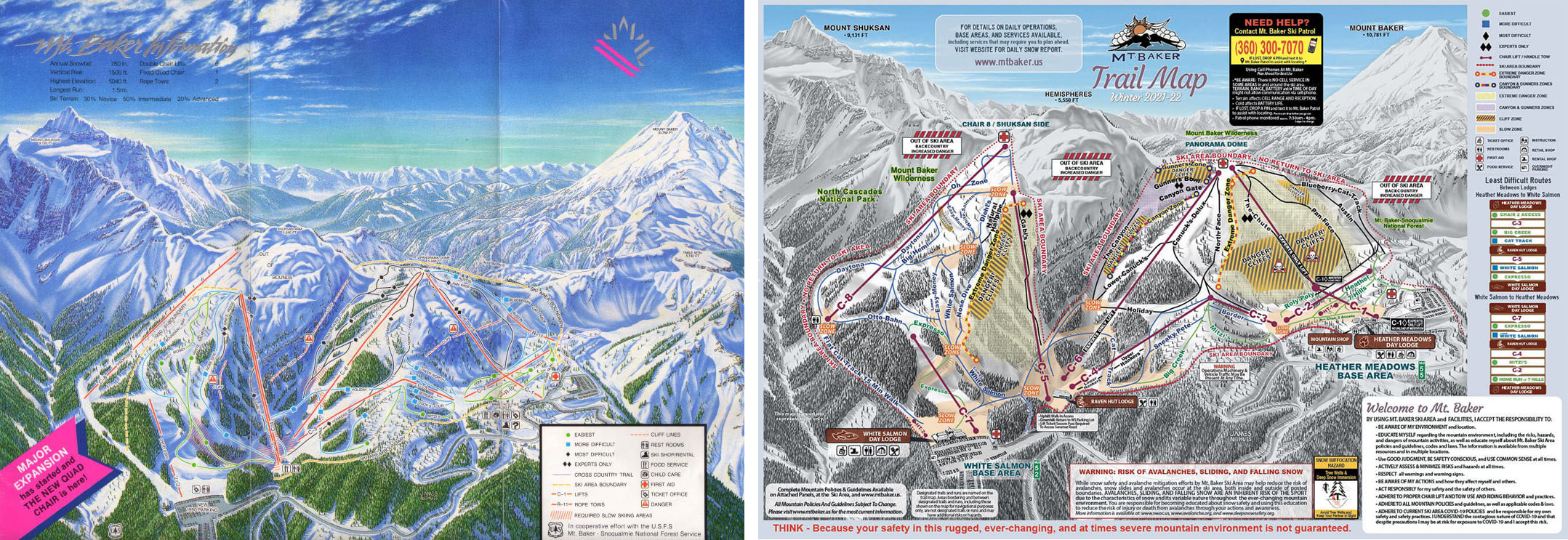
Credit to skimap.org
The only notable terrain expansions have been the addition of the Northway chair at Crystal and White Pass’s Paradise Basin expansion. All additional capacity since then has come from chairlift upgrades to increase uphill capacity through larger chairs and/or high speed, detachable chairlifts (and the gondola at Crystal). For some of those maps it’s also interesting to see that the parking lots are almost entirely unchanged since 1990 as well.
This lack of investment worked for a while but in the past few years it has really started to bite. In early 2020, in response to overwhelming demand Crystal stopped selling walk-up day tickets.3 Then in 2022, Crystal implemented a parking reservation system in an attempt to better control its parking lots.4 Stevens has similar problems. On any given weekend the parking lots at the base area will be full and the overflow lots further down the highway at Yodelin and the Nordic Center will be in use. On some weekends even those fill to capacity and anyone that shows up too late is turned away entirely. Efforts are being made to encourage carpooling and the use of shuttles/buses to get people to the mountain but those do not address the lift/terrain capacity issues.
In addition to implementing reservation systems to control overcrowding, ski areas have also started to raise prices to manage crowds as well. Since the 2018 Alterra acquisition Crystal went from the $600 no-blackouts Ikon Base Pass to $1,800 for the equivalent pass starting next season. If you don’t want to have to make reservations to visit your home mountain you’ll need the $4,100 premier pass. It’s a similar story with day tickets as well: a weekend day ticket will run you around $185 before tax and parking costs. For a family a single day on the mountain can easily be a $1,000+ endeavor.
For better or worse, this combination of dramatic price hikes and parking reservations does seem to be making a dent in overcrowding. But this does not mean those extra people have simply disappeared. It means they are either skiing less, taking trips out of state, or simply being priced out of the sport entirely. The latter being the most concerning in that what happens to the sport when only the wealthy or already established skiers can partake? How do you grow a sport when it costs hundreds or thousands of dollars to simply try it for a day? What happens when the next generation grows up without any interest in winter sports?
To be clear, this is not to say that skiing has ever been a cheap sport. It has always been expensive when considering the amount of gear needed, transportation to the mountain, and lift tickets. However, it has nevertheless traditionally been accessible for average middle class families. For example, small, local ski areas have/had reasonable day ticket prices and ski swaps make used gear fairly cheap to obtain. There is a big difference between a day trip to your local ski area and a week vacation at Aspen, but we are increasingly losing that low end of the spectrum.
The conclusion is that our ski areas are vastly overcapacity. And with more population growth in the future, we need to plan for how to at least somewhat keep pace with that population growth. Make no mistake, there is no answer to this problem than expansion of ski areas. The policies currently being used to make more efficient usage of current facilities will only work for a certain time period, not indefinitely. In the meantime these problems will undoubtedly continue to get worse before they get better. But if we don’t start to solve them in the near future we risk simply pricing out even more people and turning skiing/winter recreation in general into something only attainable for the wealthy to the detriment of the sport at large and the population of Washington who lose out on the ability to enjoy the mountains in their backyard.
Solutions for the future
Alright, so there are some major challenges facing skiing in the PNW. What can we do to address them?
There are four areas of focus that would go a long way to providing sufficient access not just for mechanized skiers, but backcountry skiers, snowshoers, and general snow play areas for children and families:
- Expansions of existing ski areas
- Creation of a new ski area to provide competition to the large ski corporations
- Winter maintenance to high elevation trailheads for ski touring, snowshoeing, and sledding
- Increased focus on winter recreation community groups for ongoing advocacy on issues of access
This post focuses exclusively on the first item, expansion of existing ski areas. In the next post I will explore some potential solutions to the latter three items.
It’s no surprise that the easiest and most realistic option to provide more opportunities to our winter mountains is to expand our existing ski areas. Due to wilderness and roadless areas, some of these ski areas have an easier time than others with expansion. Let’s look at each of the six ski areas in the Cascades to consider their unique challenges and possibilities.
Stevens Pass
Arguably the mountain the most badly needs increased capacity is Stevens Pass and thankfully it is likely the best positioned of our ski areas to expand. Its last major expansion took place in the 1980s with the development of the Mill Valley area (the backside as it is colloquially referred to). Since then, the Hogsback, Skyline/Barrier, Brooks, and Jupiter chairs have been upgraded to high speed chairlifts but beyond that the overall terrain and notably parking have remained the same aside from the small lot G being added a few years ago.
Years ago, Stevens published their master plan which at the time considerably expanded terrain and number of chairlifts. This proposal was made in 2008 with the forest service but the plan was disputed by The Sierra Club5. By 2017 (10 years later!), when approval for the additional chairlifts was finally received the Vail acquisition was right around the corner.6
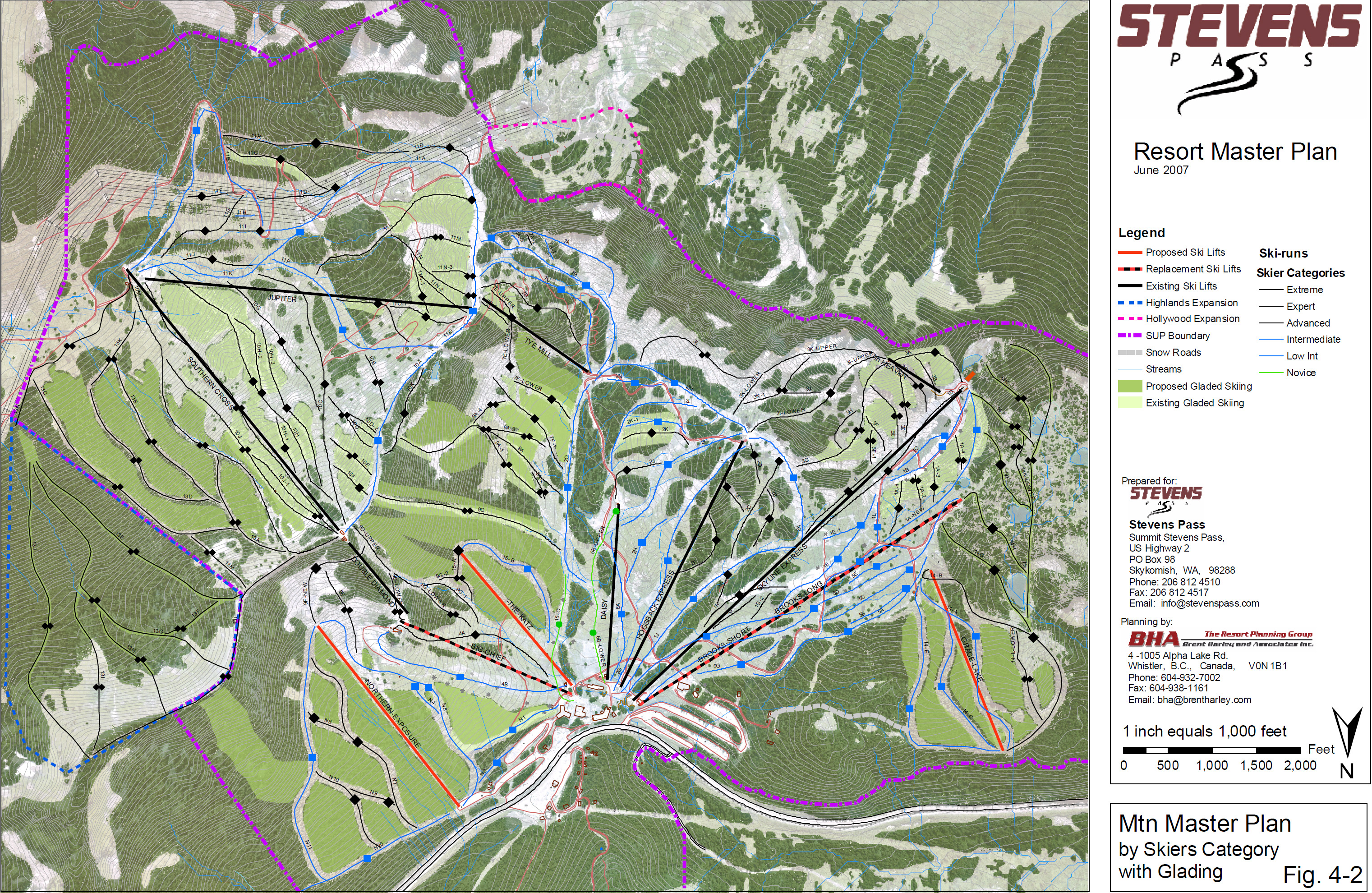
We don’t know what Vail’s long term plans for Stevens are. Since the acquisition they have upgraded the Brooks chairlift from a fixed group double to a high-speed quad and replaced the beginner Daisy lift. Welcome changes, but upgrades for two lifts that serve beginner terrain a substantial capacity upgrade does not make. It is doubtful that Vail has any notable expansion plans for Stevens as in their business model Stevens acts as a feeder mountain to capture some percentage of the Seattle market, sell them Epic passes, and get them to their destination mountains; mainly Whistler for the Seattle market.
For that reason, I can’t say I’m hopeful that anything will come to fruition with Stevens but let’s consider what could be done anyway:
- The 2007 master plan still rings true, especially with the additional lifts been given the nod from the forest service.
- The proposed Northern Exposure lift would add desirable intermediate and advanced terrain.
Kehr’s chair should be upgraded to a quad chair (fixed grip or high speed).This would help spread out crowds on the other frontside lifts, Hogsback, Skyline, and Brooks as well as correct the currently odd situation of having a double chair feed into a triple (Double Diamond).- Since I originally wrote this, Stevens has announced that Kehr’s will be upgraded to a fixed-grip quad for 2023. Yay!
- The proposed Grace Lakes chair would open additional intermediate, advanced, and expert terrain as well.
- Some of this terrain is already skiable as lift-served backcountry for those whom know where they’re going, but having a lift and having it be avalanche controlled in-bounds terrain would open it up to many more people.
As for the parking situation, Stevens is limited by its small base area. There simply is not much level land left for adding additional parking; certainly not enough to keep up with demand. One suggestion I have heard tossed around on the chairlift is putting additional parking in at the bottom of Mill Valley accessible through the Nordic Center. There is already a forest road running the length of the valley and it is cleared for the power lines that run in the valley as well. However, given this narrow valley there is potentially the problem of avalanche danger that would need to be mitigated. Moreover, this is a ~5 mile road to maintain which would be expensive to keep clear. It would also disrupt the trails around the Nordic Center.
A more practical parking scenario could take place in conjunction with a Grace Lakes lift. As anyone that has skied back there will tell you, parts of it are flat, like “take off your skis and walk” flat. Plus, there is already a snowcat road that goes up there which could be converted to a road for cars with minimal effort. Furthermore, there are some naturally treeless areas which would minimize tree cutting. This would allow for a considerable amount of additional parking near the base area without the need to do difficult, intrusive, and expensive re-grading or the need to maintain a lengthy road in the winter.
Crystal Mountain
Crystal Mountain is, admittedly, a difficult mountain for me to write about. Partly because they have recently announced major development plans, but also because I don’t know if there are many solutions for Crystal to increase its capacity. It is already Washington’s largest ski area by a sizeable margin and it’s still overcapacity; which gets to the point that we need another ski area in general but more on that in my next post.
Before looking at Crystal’s current plans let’s consider their 2004 master plan:7
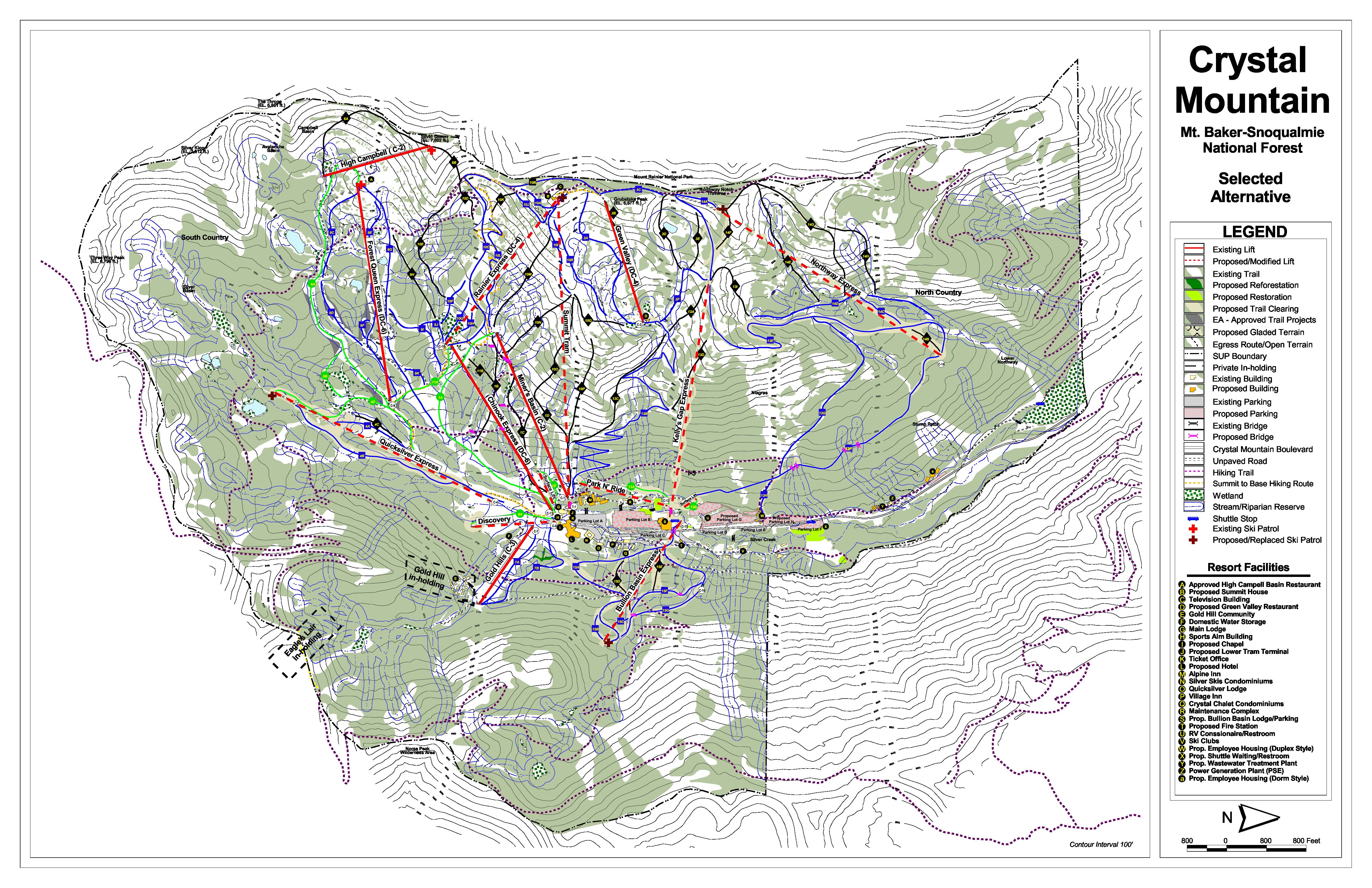
This includes some projects that have come to fruition. Namely, lift upgrades, the gondola, and the Northway lift.
However, there was a proposal for chairlifts along the East Peak and Southback areas. These were denied by the forest service due to concerns about affecting dispersed recreation (backcountry skiing) and also purposefully to make it more difficult to access the Norse Peak Wilderness. The 2004 Record of Decision7 states the following:
My decision eliminates the C-16 (East Peak) chairlift, to address concerns over the potential for skiers to enter into Norse Peak Wilderness.
Even though, it goes on to say that anyone from the ski area would not be permitted to access this land regardless:
Under the Selected Alternative, the SUP boundary will be closed to ticketed skiers and enforced by Crystal Mountain, which will minimize the likelihood of ticketed skiers from entering into the MRNP or Norse Peak Wilderness.
Which is fairly ridiculous to me as this is public land that is being actively discouraged from use by making it purposefully difficult to access.
The decision also states that there was no need to develop a chairlift in the Southback area because the existing High Campbell lift had sufficient capacity:
With no clear evidence that C-6 (High Campbell), which accesses expert-only terrain, exhibits capacity use, I am not convinced of the need to develop a chairlift in the South Country.
15+ years on, would it be fair to say that times have changed?
Beyond these additional chairlifts that could be added, Crystal appears to be taking its development in a different direction. Its Reimagine Crystal project8 significantly upgrades mountain facilities through base area and mountain-top lodge construction in addition to a large hotel. However, new terrain or chairlift upgrades are notably absent. These are puzzling decisions but I imagine that the hotel stems from the desire to transform Crystal into more of a four season resort in order to generate summer revenue and offset loses from any future poor snow years. This also helps get more people staying on the property which alleviates a small amount of morning traffic and parking issues. Nevertheless, it is disappointing to see no lift or terrain expansions in these plans.
The biggest capacity issue facing Crystal though is just that, parking. This is demonstrated by how its policy for limiting access has turned to one of managing parking capacity rather than lift capacity.9 Crystal states that expanding their parking is not within the purview of their environmental goals. Besides, even if they did, there is a finite capacity to the number of cars that Rt. 410 can handle on a given morning. Thus, like some other ski areas with the same problems, they have resorted to using buses to get people to the mountain. Buses are certainly one piece of the puzzle, especially since some people are perfectly happy to not have to drive themselves all the way to the mountain. I would be interested in exploring one other possible solution though: parking garages.
I know, a parking garage in the middle of the Cascades sounds ridiculous and you’re likely thinking how addicted can I be to my car to even suggest this? Maybe so, but a parking garage has two attractive properties that warrant consideration:
- It allows for increased parking capacity without disturbing additional land.
- Covered parking would not need snow removal and could therefore have a high number of EV charging stations.
If the goal is to reduce transportation-related emissions then the largest focus should be promoting EV use to get to the mountains. Assuming that the power grid connection there can handle it, having a garage full of EV charging stations could significantly help drive adoption if drivers knew their car could charge while they ski instead of having to stop somewhere along the way home (if they didn’t have the range already).
The likely problem with this is cost though. It’s difficult to pin down even a ballpark number but let’s assume it would be in the millions of dollars range for anything substantial. That’s a lot of money to throw at parking and it also doesn’t solve the problem of road capacity to get to the mountain in the first place. There is some history of this though. A garage was studied for use at The Summit at Snoqualmie in the past. However, the forest service decided against it stating:
To address concerns over limited parking at Summit Central, Summit West, and Alpental, an alternative was develop to provide parking structure in the existing Lot 1 at Summit Central. This alternative was eliminated for two main reasons: economics and visual quality. Primarily, the construction of a parking structure would be prohibitively expensive. If the proponent were to build a parking garage, it would be necessary to recover the cost by charging parking fees. With free parking available elsewhere, ski area guests would have little incentive to use a pay parking area, except for during capacity operations. Such limited use would not provide sufficient economic return to justify the cost of constructing the parking structure.10
Given that we’re now living in an effectively post-free parking era the economics may make sense now. That said, a garage is not a silver bullet and would only be one part of a multi-pronged approach to more efficiently get people to the mountain while also reducing emissions. More research is needed here.
Another option to alleviate some parking issues would be to maintain winter road access up to Cayuse Pass for use with backcountry skiers. More on backcountry-specific issues in my next post though.
Mt. Baker
Mt. Baker is your esteemed author’s home mountain. Its fiercely independent attitude, no frills nature, and energetic atmosphere grant it a special place in my heart. Every winter weekend at Mt. Baker I am reminded of ski areas of past: the video updates on the snow report, the still mostly reasonable lift ticket prices, the puns on the day tickets, events like the annual golden egg hunt, even the fixed grip chairs continually remind me of what a gem it is. The backcountry culture at Baker is bar none as well. I would be devastated if any of this ever changed, but we also need to recognize that in order to allow this culture to continue into the future we need to keep the ski area accessible for all who wish to use it. This requires changes and expansions.
Just like all other ski areas in Western Washington, Baker is showing growing pains. The increasing population around Bellingham as well as some Seattle skiers trying to escape the crowds are putting pressure on Baker. As a result, they have begun capping the number of season pass sales. On big days it’s also possible for the mountain to run out of parking (reportedly they are working on expanding parking slightly which will definitely help with these growing pains11).
Most problematically though is that Baker is nearly landlocked by wilderness areas. Assuming they wanted to expand their terrain they have few options for doing so. Which is a big if too since as far as I know Baker has no desire to become a large ski area.
Another issue that Baker has to contend with is that it is not connected to the power grid. As a result, all of its chairlifts, except for chair 7, are powered by diesel engines. To Baker’s credit, this summer they are upgrading chairs 4, 5, and 6 to electric engines.11 These chairs are then powered by a generator which, while still burning gas, I’d assume is more efficient. At some point in the future, I’d hope that Baker will become connected to the power grid so this power source could be swapped out for a renewable source. Otherwise, I could see this becoming a liability for Baker under Washington’s cap-and-trade emissions reduction program as part of the Washington Climate Commitment Act.12
Out of all of the mountains I researched for this blog post, Mt. Baker is the most difficult to get any info on. The usual suspects of EISs, master plans, records of decision from the forest service, etc. have turned up nothing. I was unable to even find a map of their permit boundary. However, one FOIA request later and I obtained such a map which allows me to shed some light on what may be possible.
So, what could Baker do? Well, if wilderness areas are not adjusted, not much unfortunately aside from upgrading lifts to be higher capacity/detachable. Consider the map of the wilderness areas (in grey) that surround Baker’s ski area permit boundary:
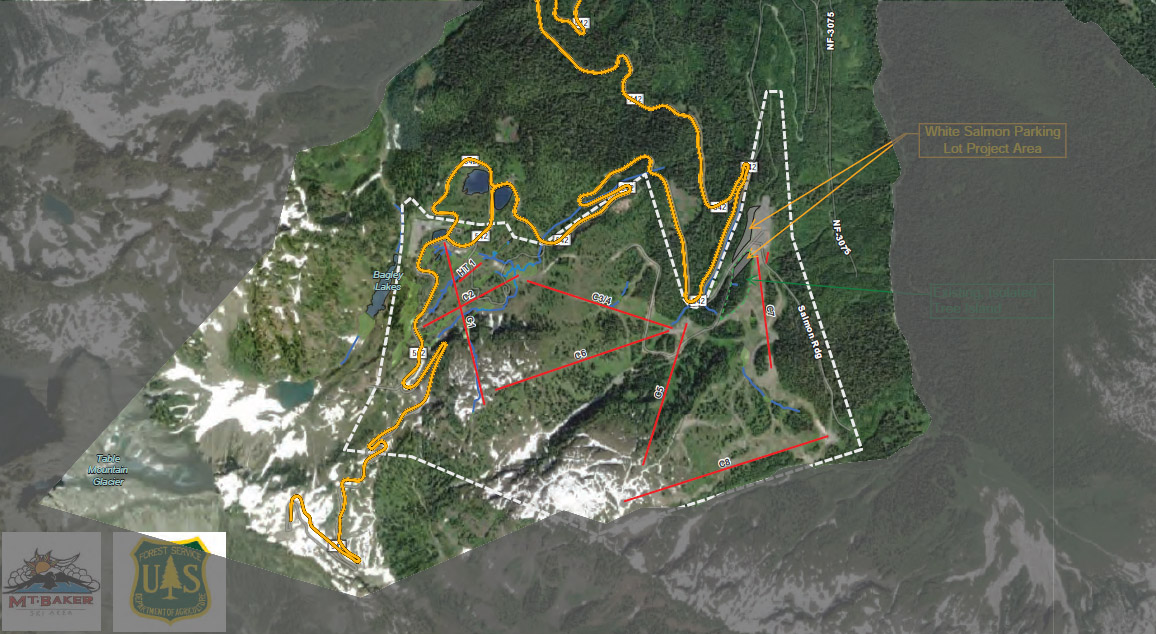
There are some possibilities here, but if you include roadless areas as well it becomes even more limited with Mt. Herman taken off the table completely as well as most of Hemispheres. That said, as I touched on in my previous post, it’s not clear how the 2001 roadless rule affects existing ski area expansions into these areas. Assuming that were allowed, Baker does have some limited options for expansions while staying outside of the wilderness areas:
- A chairlift up the eastern side of Mt. Herman
- Anything in the Bagley Lakes area would need to be combined with a way to get back up to the base area as well. This could be as minimal as a rope tow or T-bar possibly.
- This area could be problematic for construction though since as the name implies, there’s a handful of lakes here.
- A chairlift towards Artist Point or the eastern side of Table Mountain
- Anecdotally, I’ve had conversations with people who claimed these were in the plans for Baker at some point in the past but I’ve never found any documents supporting that.
- A chairlift to the top of Hemispheres either from the top of chair 8 or from gunners ridge off of chair 1
- This area could be problematic to avalanche control, however. Being above treeline would make it difficult to ski in whiteout conditions.
- A chairlift down into Swift Creek
- This would be going into lower elevation terrain which would be marginal skiing at times. Plus, it would be south facing.
In 2012, the previous manager of Baker, Duncan Howat, briefly addressed expansion options in an interview with Mt. Baker Experience magazine where he stated mostly the same problems outlined above:
Given our master plan and the terrain around us, it’s pretty tightly locked up. There is some recreation land surrounding us, but not a lot. There’s a little bit on Mt. Herman but that creates some problems on its own. You could theoretically go up to the top of Hemispheres but I don’t think most people would want that because they like it as a hike. It’s more of a fine-tuning of what we have.
He also addressed the possibility of new chairs within the existing ski area to address capacity issues:
You could put one at the top of the Chair 3 area and run all the way down to the sewage treatment plant. There’s a chair that could go where you get off at Chair 7 and would go all the way to the top of Chair 8. At one time, we laid out a chair at Austin called the Up and Up that went up over the backside.
For what it’s worth, these would be welcome additions. A chair from the top of 7 to the top of 8 would relieve the usually long line at 5 and one near Austin would make skiing that area much more convenient without the hike from the top of 1 to Austin as well as relieving the line at 1’s midstation.
But besides intra-ski-area chairs, any of this expansion comes at the cost of displacing terrain that is currently heavily used for backcountry skiing, and snowshoeing in the case of Artist Point. As someone that skis these areas regularly myself, this not a proposal I make lightly. Us ski tourers must recognize though that for the larger good of our sport, the ski areas must expand outward from where they are to increase their capacity so the pipeline of newer skiers can continue inside the ski areas as overall demand grows. This isn’t all bad though, for those of us with passes at Baker a chairlift towards Herman or Artist Point means quicker access to the terrain beyond those areas. For those without a pass, Baker could offer a backcountry specific ticket good for limited use only to get to the backcountry terrain similar to what Whistler does.13 In principle, any conversion of currently easily accessible backcountry terrain should be replaced with similar terrain access elsewhere. Again, more on this in my next post though.
Alpental
Similar to Mt. Baker, Alpental is fairly boxed in by wilderness areas preventing any major expansions. From their 2005 master plan we can see its permit area covers what is essentially the current ski area + the back bowls in addition to a small amount of terrain on the other side of the valley.
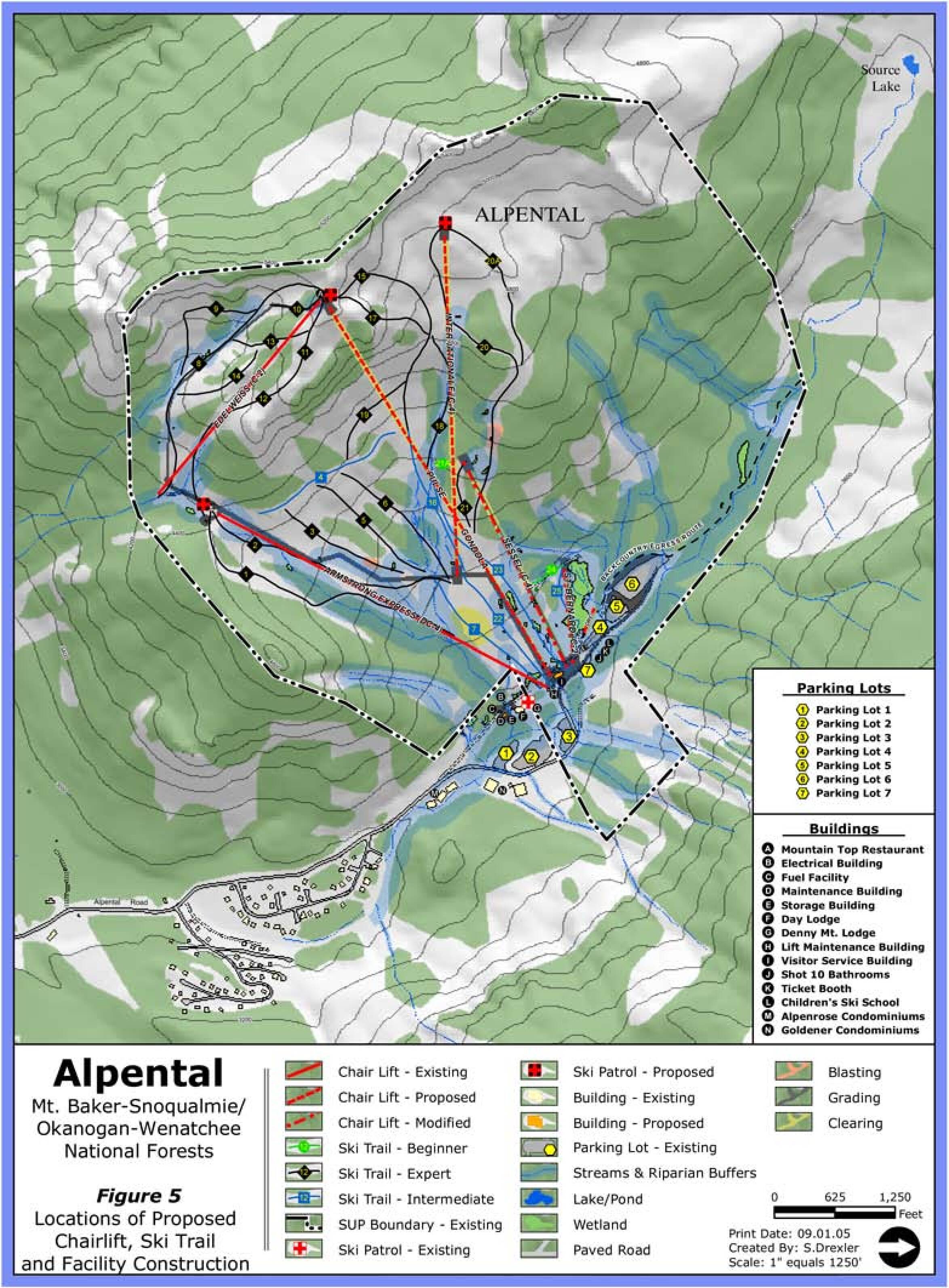
This stands in contrast to the original plans for Alpental when it was founded to build a tramway on the east side of the valley to Cave Ridge and then a chairlift to the summit of Snoqualmie Mountain.14 This would have essentially doubled the size of Alpental from what it is today and bring its top elevation nearly 1,000ft higher to ~6,200ft. This also could have served as a base for future expansions on the other side of Snoqualmie Mountain onto north facing terrain. Alas, these plans died in 1976 when Snoqualmie Mountain was included in the Alpine Lakes Wilderness.
The 2005 master plan also called for a pulse gondola to be installed from the base area to the summit along with a small summit lodge that would operate year round serving as a restaurant, sightseeing, and recreation location. Note that a pulse gondola is different from a detachable gondola in that it has limited, fixed grip cabins which travel in a pack as shown in the illustration below.
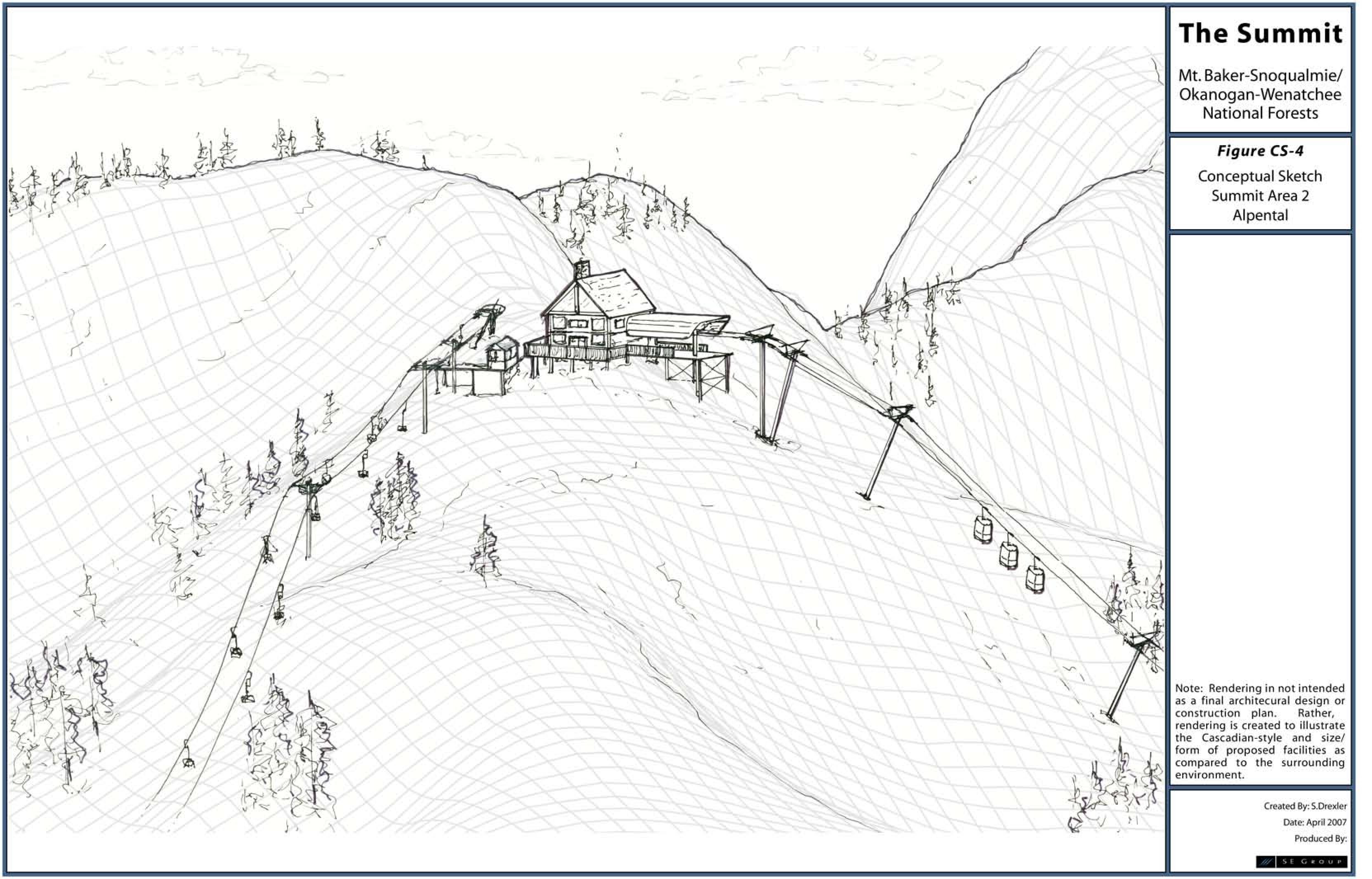
These plans were dropped, however, per the forest service’s rationale:
In order to address concerns over low freezing levels, two alternatives were developed to increase access to and round-trip skiing on the high elevation terrain at Alpental. The first alternative considered a revised location of the proposed Pulse Gondola to create a mid-station at the bottom of Upper Internationale. In the MDP, the primary purpose of the gondola would be to address summer recreation and access to the mountain-top restaurant for all users. In this capacity, the gondola would provide little round-trip skiing, particularly for skiers below the expert ability level. In order to address round-trip skiing, the gondola would have to be upgraded to a higher capacity lift. This alternative was eliminated from further consideration because the proposed Internationale lift already addresses the need with less cost compared to a high-speed gondola.10
Which, in all fairness, does make sense. A pulse gondola, while great for summer access, would do little to handle heavy skier traffic. With Armstrong Express having been built, the proposed gondola would have served little winter purpose. Although I could see a mountaintop restaurant accessible via gondola so close to Seattle being a popular destination on nice summer evenings.
As a small digression, in response to the 2005 proposal The Sierra Club (of course) argued for actually shrinking the size of the ski area and preventing future lift infrastructure with the following proposals:10
- The lift system at Alpental would not expand to the west of the existing infrastructure.
- Reduction of the permit boundary on the west end of Alpental.
- Reduction in the permit boundary east of Mt. Hyak, resulting in elimination of approximately 150 acres of permit area.
- Redesignation of the permit area on the east slope of Mt. Hyak and northeast slope of Mt. Catherine.
For an organization that states on their website’s home page “We believe in getting people outside to enjoy the outdoors” they sure have a funny way of going about it. Anyway…
The most notable item to discuss about Alpental are the Summit 2030 plans. This involves three notable projects:15
- Building the proposed International triple chair as roughly shown in 2005 plans above.
- Upgrading and re-aligning Sessel for access to the new International chair and for better access to intermediate terrain.
- Upgrading Edelweiss to a triple chair
All of this will significantly increase uphill capacity which I think we all can applaud. Looking beyond these projects though, is there anywhere Alpental could expand into new terrain? Well, not really without considering wilderness areas. It could add more chairlifts into its current back bowls which are already in its permit boundary. Beyond that, there is a small window on the other side of the valley that is not a wilderness area while still wide enough for a lift. Really though, the best and highest terrain would likely be the original plans from the 1960s with a chairlift to the top of Snoqualmie Mountain. Just one chairlift there would open a considerable amount of high elevation terrain. In fact, it may be the only way to keep skiing in Snoqualmie Pass with climate change.
What about the other side of the highway? Where is Summit East, West, & Central in all of this? The Summit 2030 plans have improvements for Summit too. However, the long term climate trends for skiing in Snoqualmie Pass is not looking good. In my post on the Cascade snowpack I noted that unlike other ski areas in the Cascades, Snoqualmie is starting to see decreased snowpack year over year. With this trend certain to continue for the foreseeable future, the days of skiing at Summit may be numbered. The base elevation of Snoqualmie Pass at 3,000ft is simply too low to avoid the coming effects of climate change, even with its access to the cold eastern Washington air coming up the pass. Alpental may be spared with its higher elevation, but all it takes is a few bad snow years to make a ski area uneconomical and fold entirely. Snoqualmie in particular is problematic for this as well due to how much of the Seattle market is served by its terrain. For skiing to continue in Snoqualmie pass in the coming decades it may likely be necessary to reclassify some of the higher elevation terrain currently in wilderness areas to replace or swap the lower elevation terrain that will become nonviable for a commercial ski area.
Mission Ridge
Mission Ridge is currently attempting to undergo a significant expansion. Namely, they are building the following:16
- Expanded beginner terrain & new chairlifts to service this terrain
- Additional day-use parking
- A snow tubing area and nordic trails
- A small village area with restaurants and shops
- Condos, townhomes, and single family homes
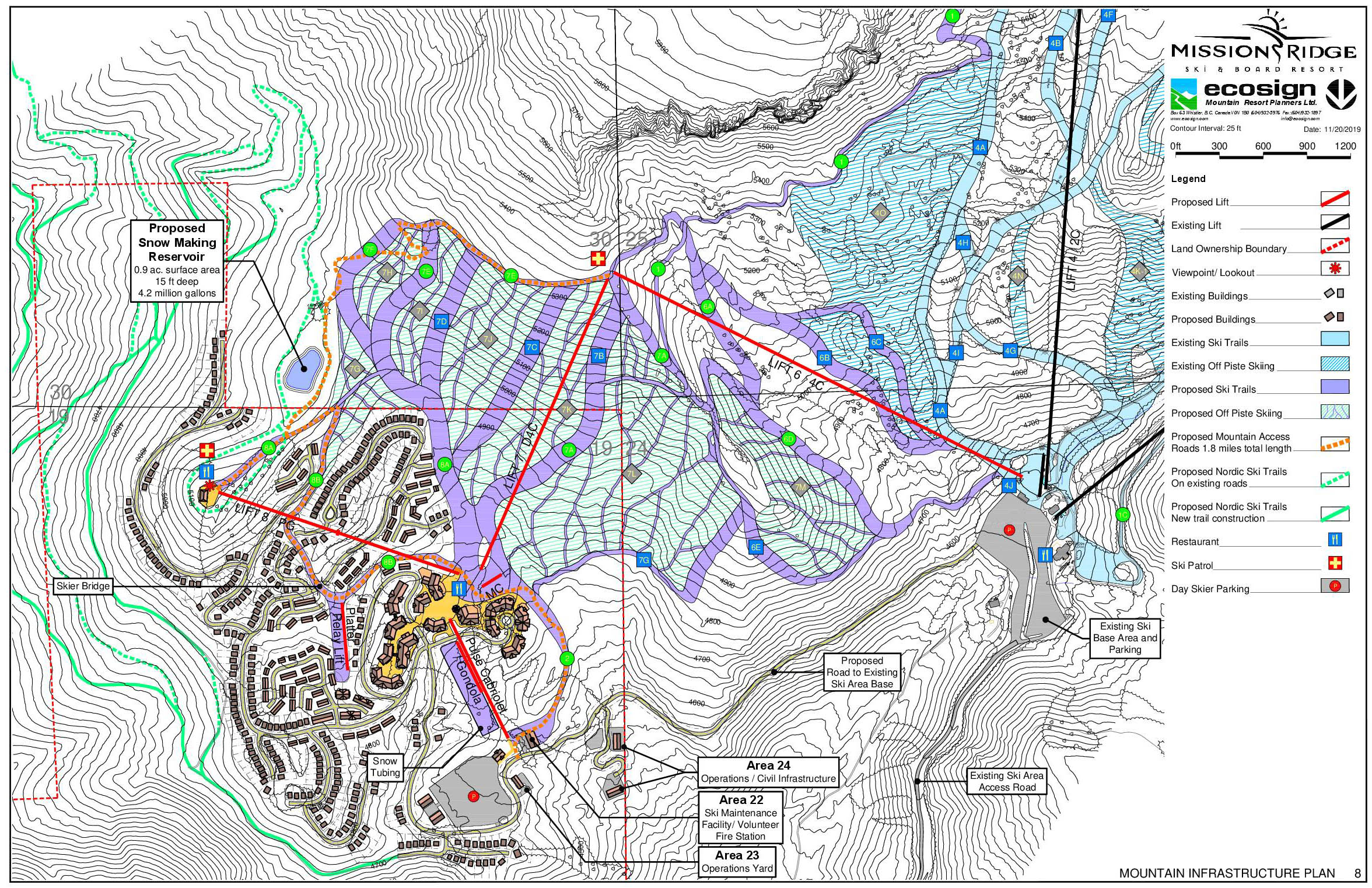
Mission Ridge is unique in that it currently sits on the edge of national forest land. Thus, in 2014 the owner of Mission Ridge bought ~800 acres of adjacent land that is privately owned. This is what allows them to build out such a significant base area. Although I can’t say I’m excited about development of so much private housing like this in our mountains, that is the is advantage of privately owned land: you can do (mostly) what you want with it.
Despite sitting on private land, the Mission Ridge expansion faces permitting issues with this project. When the project was proposed in 2015 they believed construction could begin circa 2017. Now, seven years, $1 million, and a lawsuit later and it’s still mired in legal battles and red tape.17 We can only hope that the legal costs don’t become high enough to kill the project as tends to happen in Washington.
White Pass
White Pass is a difficult ski area for me to write about. Mainly because it is the furthest ski area from me and thus I know the least about it. I know little of its present day challenges. The only plans I know about are to expand its lodges. As for parking, White Pass is blessed with a good amount of fairly flat land at its base that could be used to expand parking in the future if necessary.
Would it be possible to expand its terrain if desired in the future? Sort of. Similar to Mt. Baker and Alpental, White Pass is nearly boxed in by wilderness areas. From their 1990 expansion plans though, there was a proposal to put another lift in below the current Couloir Express.
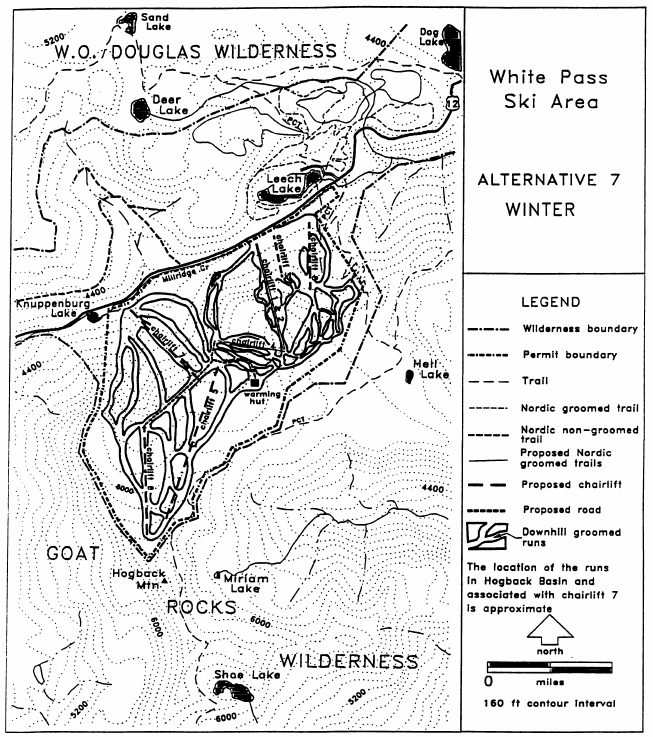
I don’t know why this “chairlift 7” was not built, whether it was a permitting issue, funding issue, or simply that the capacity has not been needed yet. More info is needed here, but in theory it could be a viable option for future terrain expansion at White Pass.
If needed in the future, it would in theory also be possible to replace Chair 2 with another high-speed quad to increase uphill capacity.
Conclusions
To summarize, what we can determine from all of this is that our existing ski areas need to expand to meet demand from ever increasing population growth. However, there are significant challenges to doing so which are unique to each mountain. The biggest long term challenge is parking closely followed by lack of terrain to expand into due to being surrounded by wilderness areas. Specifically, each mountain faces the following primary problems:
- Crystal Mountain: Crystal has some terrain left in its valley to expand, but parking options are limited and even if solved the two lane road leading to Crystal has a finite capacity as well.
- Stevens Pass: Stevens is probably best positioned for expansion. It has a good amount of terrain to build into, even within its existing permit area. Its parking situation could be improved given proper investment. Route 2 has serious traffic problems, like emergency vehicles can’t get to their destinations bad. Being a thoroughfare for cross-state travel this is not purely an issue for the ski area but rather something for WSDOT and the state to handle.
- Alpental: Alpental could build out its back bowls more, but in general it is surrounded by wilderness areas and unable to expand in any meaningful way. It and Snoqualmie sit at the lowest elevation of ski areas in the Cascades and will be the first ones affected by climate change in the coming decades. Putting substantially more money into Alpental/Snoqualmie is likely not a prudent investment or use of time/effort. The danger here is that we may well be losing a significant amount of ski capacity. What could be done to replace it elsewhere?
- Mt. Baker: Like Alpental, Mt. Baker is nearly completely boxed in by wilderness land. There are only a few limited options for them to open more terrain.
- Mission Ridge: Mission Ridge is currently undergoing a significant expansion so there’s no much to say here.
- White Pass: White Pass was nearly doubled in size not too long ago, it may be okay for a while longer provided parking capacity keeps up. Although if it does need to expand in the future, it also has few options due to being boxed in by wilderness areas.
Some of these expansions will need to take place in order to meet demand and keep skiing accessible. Not necessarily all of them nor all at once, but keep in mind how long these projects take: decades easily. Because of that the ball must get rolling in the near future if we are to keep skiing at least somewhat accessible.
However, expanding ski areas is just one piece of the puzzle. If we want to keep skiing affordable and accessible we’ll realistically need a new ski area that is owned and operated in a manner different from the commercial, corporation-owned ski areas we currently have. In order to form a complete vision of what skiing in Western Washington could be we’ll need to consider new mountains to open and different models for running these mountains. The final post in this series will be where things get interesting.
Sources
-
In response to overcrowding over the weekend, Crystal Mountain changes its ticket policy ↩
-
Crystal Mountain New parking management plan to begin January 15th ↩
-
Activist group opposes plans to expand Stevens Pass ski area ↩
-
Crystal Mountain Master Development Plan Final Environmental Impact Statement ↩ ↩2
-
Alternatives Considered and Modifications to The Summit-at-Snoqualmie Master Development Plan ↩ ↩2 ↩3
-
Written in the Snows, Lowell Skoog, p190 ↩
-
Mission Ridge says expansion project faces ‘disjointed’ application process ↩




